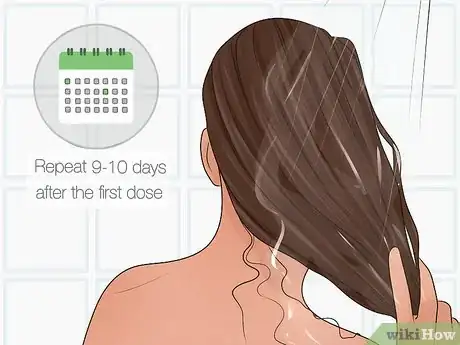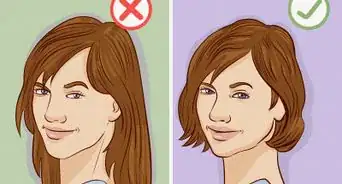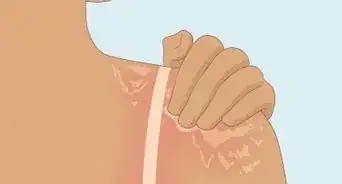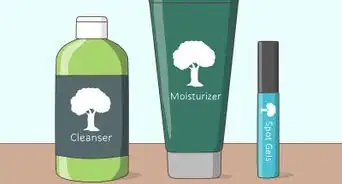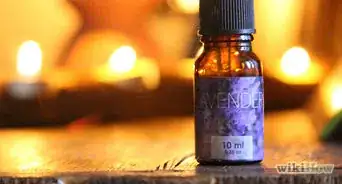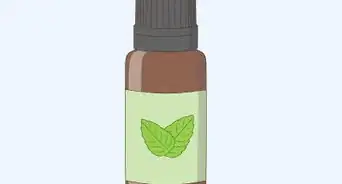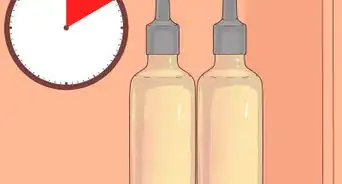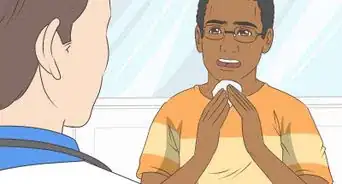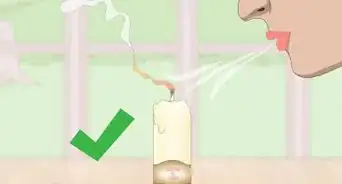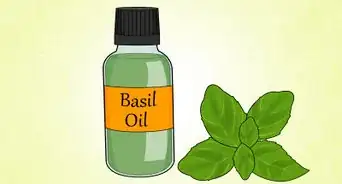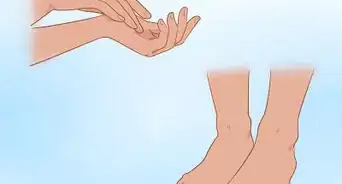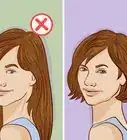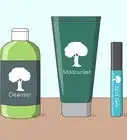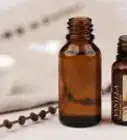This article was co-authored by Zora Degrandpre, ND. Dr. Zora Degrandpre is a Natural Health Doctor and Licensed Naturopathic Physician in Vancouver, Washington. She is a grant reviewer for the National Institutes of Health and the National Center for Complementary and Alternative Medicine. She received her ND from the National College of Natural Medicine in 2007.
There are 13 references cited in this article, which can be found at the bottom of the page.
wikiHow marks an article as reader-approved once it receives enough positive feedback. In this case, 85% of readers who voted found the article helpful, earning it our reader-approved status.
This article has been viewed 461,727 times.
If you’re looking to get rid of head lice fast, you’ve probably heard about using tea tree oil as a natural method. Does it really work, though? Yes and no. Anecdotal evidence and some medical studies suggest that tea tree oil can get rid of head lice (as well as eggs), but few medical sources support it as a verified method. Read on for information on tea tree oil's effectiveness and more!
Steps
Will tea tree oil actually remove lice?
-
1Potentially, but it's not the most effective method. Tea tree oil isn't regulated by the FDA because it is an essential oil. This makes doctors hesitant to recommend it as a good treatment. Independent medical research suggests that tea tree oil can be an effective treatment method, though. [1]
- A study published by Parasitology Research found that tea tree oil contains insecticidal properties that kill lice. It concluded that tea tree oil was an effective treatment.[2]
- Another medical study in Australia found that the combination of tea tree oil and lavender oil was a successful treatment against lice.[3]
-
2Over-the-counter treatments are still more effective. This is usually what doctors recommend. These usually come in the form of an anti-lice shampoo. To kill the lice, the shampoo includes active ingredients like pyrethrins or permethrin lotion.[4]
- The shampoo can't kill unhatched eggs, so you'll need to do two rounds of treatment. Follow the first treatment with another 9-10 days later. This will get rid of any lice that hatched after the first round.[5]
How do you use tea tree oil to get rid of lice?
-
1Mix tea tree oil in your shampoo. Mix 3 to 5 drops of tea tree oil for every 1 oz of shampoo.[6] Wash your hair with the product in the shower. After, work a fine-toothed comb through your hair. Use the comb to get rid of any lice or nits (lice eggs).[7]
- Always combine tea tree oil with another substance, like shampoo or a carrier oil. Tea tree oil can be pretty harsh on your skin. Diluting it makes it more gentle!
-
2Alternatively, make a solution of olive oil and tea tree oil. Apply a combination of 3 tablespoons (44 mL) olive oil and 1 teaspoon (4.9 mL) tea tree oil to your hair. Wait for 30 to 40 minutes before washing out the solution.[8] A study by Parasitology Research found that it takes about 30 minutes for the tea tree oil solution to effectively kill the lice.[9]
Do any other essential oils get rid of head lice?
-
1Neem oil can be used to kill head lice. A study done by Parasitology Research found that shampoo containing neem oil effectively removes lice. In the study, children were given the treatment for 10-20 minute periods. After 7 days, the shampoo killed all the lice and eggs.[15] To use this method, use a neem oil shampoo or add 10 to 20 drops of neem oil to 1 oz of your normal shampoo.
- Leave the shampoo in your hair for 20 minutes before washing it out!
-
2Lavender oil is another remedy you can try. The National Library of Medicine published a study that suggested lavender oil as a semi-effective method to get rid of lice. The research noted, though, that tea tree oil was more effective.[16] To use lavender oil, mix 2 drops of lavender oil in 10 millilitres (0.35 imp fl oz; 0.34 fl oz) of water. Use this instead of shampoo 2-3 times a week for 3 weeks.
- Lavender oil does not kill nits (lice eggs).[17]
Expert Q&A
-
QuestionI did all the things recommended to remove head lice but it's very disgusting to find them again after all the struggle.
 Zora Degrandpre, NDDr. Zora Degrandpre is a Natural Health Doctor and Licensed Naturopathic Physician in Vancouver, Washington. She is a grant reviewer for the National Institutes of Health and the National Center for Complementary and Alternative Medicine. She received her ND from the National College of Natural Medicine in 2007.
Zora Degrandpre, NDDr. Zora Degrandpre is a Natural Health Doctor and Licensed Naturopathic Physician in Vancouver, Washington. She is a grant reviewer for the National Institutes of Health and the National Center for Complementary and Alternative Medicine. She received her ND from the National College of Natural Medicine in 2007.
Natural Health Doctor It can be frustrating. Did you got through all the bedding and towels and wash them in hot soapy water? Have you cleaned and vacuumed all your furniture and rugs or carpeting. Are there others in the family or the home who may be re-infecting you? Try checking all those things to see if there is a source of lice in your home.
It can be frustrating. Did you got through all the bedding and towels and wash them in hot soapy water? Have you cleaned and vacuumed all your furniture and rugs or carpeting. Are there others in the family or the home who may be re-infecting you? Try checking all those things to see if there is a source of lice in your home. -
QuestionMy granddaughter's hair is so thin and fine that every comb, including baby combs, won't get the eggs and nits out. We've even tried a brush. What do I do?
 Zora Degrandpre, NDDr. Zora Degrandpre is a Natural Health Doctor and Licensed Naturopathic Physician in Vancouver, Washington. She is a grant reviewer for the National Institutes of Health and the National Center for Complementary and Alternative Medicine. She received her ND from the National College of Natural Medicine in 2007.
Zora Degrandpre, NDDr. Zora Degrandpre is a Natural Health Doctor and Licensed Naturopathic Physician in Vancouver, Washington. She is a grant reviewer for the National Institutes of Health and the National Center for Complementary and Alternative Medicine. She received her ND from the National College of Natural Medicine in 2007.
Natural Health Doctor It may help to cut your granddaughter's hair a bit shorter to make it easier to see the eggs and nits. You may also have to apply an oily conditioner and use a pair of fine tweezers to gently pull off eggs and nits. Be very gentle and don't pull hard! The oily conditioner should make it easier to pull off the nits and eggs. To get a better view, try using a good, direct light and a magnifying glass. Also, you may want to talk to a local hairdresser and see if they have any suggestions for even finer combs.
It may help to cut your granddaughter's hair a bit shorter to make it easier to see the eggs and nits. You may also have to apply an oily conditioner and use a pair of fine tweezers to gently pull off eggs and nits. Be very gentle and don't pull hard! The oily conditioner should make it easier to pull off the nits and eggs. To get a better view, try using a good, direct light and a magnifying glass. Also, you may want to talk to a local hairdresser and see if they have any suggestions for even finer combs.
Warnings
- Tea tree oil has not been tested for safety in pregnant or breastfeeding women and is not recommended for use by these women.⧼thumbs_response⧽
- Tea Tree oil is not the most effective treatment for lice removal, although it has the benefits of being milder than other treatments. Lice infestations are serious and often persistent problems. You may want to consider conventional chemical treatments if effectiveness is the most important factor.⧼thumbs_response⧽
- Tea tree oil is toxic when ingested by mouth. Do not apply tea tree oil near your mouth, and do not ingest it orally.[22]⧼thumbs_response⧽
- Some people may have an allergic reaction to tea tree oil. If you experience redness, irritation, or itching, stop using the tea tree oil treatment.[23]⧼thumbs_response⧽
- Tea tree oil may cause hormonal side effects in pre-pubescent males when combined with lavender oil, including abnormal breast growth (gynecomastia). While no direct link between tea tree oil and this condition has been established, it is not recommended that you use tea tree oil on young males regularly.[24]⧼thumbs_response⧽
References
- ↑ https://pediatrics.aappublications.org/content/135/5/e1355
- ↑ https://www.ncbi.nlm.nih.gov/pmc/articles/PMC3480584/
- ↑ https://bmcdermatol.biomedcentral.com/articles/10.1186/1471-5945-10-6
- ↑ https://www.cdc.gov/parasites/lice/head/treatment.html
- ↑ https://www.nhs.uk/conditions/head-lice-and-nits/
- ↑ http://paf.org.au/wp-content/uploads/2015/05/Head-Lice-Treatment.pdf
- ↑ https://www.cdc.gov/parasites/lice/head/treatment.html
- ↑ https://www.newboldchurchschool.co.uk/news/parents/tips-for-head-lice-removal-and-prevention
- ↑ https://www.ncbi.nlm.nih.gov/pmc/articles/PMC3480584/
- ↑ https://www.nhs.uk/conditions/head-lice-and-nits/
- ↑ https://www.nhs.uk/conditions/head-lice-and-nits/
- ↑ https://www.mayoclinic.org/drugs-supplements-tea-tree-oil/art-20364246
- ↑ https://www.cdc.gov/parasites/lice/head/treatment.html
- ↑ https://www.cdc.gov/parasites/lice/head/treatment.html
- ↑ https://pubmed.ncbi.nlm.nih.gov/21667206/
- ↑ https://pubmed.ncbi.nlm.nih.gov/17442090/
- ↑ https://www.newboldchurchschool.co.uk/news/parents/tips-for-head-lice-removal-and-prevention
- ↑ https://www.hopkinsmedicine.org/health/treatment-tests-and-therapies/no-panic-guide-to-head-lice-treatment
- ↑ https://www.cdc.gov/parasites/lice/head/treatment.html
- ↑ https://www.cdc.gov/parasites/lice/head/prevent.html
- ↑ http://www.cdc.gov/parasites/lice/head/prevent.html
- ↑ https://www.mayoclinic.org/drugs-supplements-tea-tree-oil/art-20364246
- ↑ https://www.mayoclinic.org/drugs-supplements-tea-tree-oil/art-20364246
- ↑ https://www.mayoclinic.org/drugs-supplements-tea-tree-oil/art-20364246
About This Article
To remove lice using tea tree oil, mix pure tea tree oil, lavender essential oil, and a quarter-sized amount of shampoo in a bowl. Work the shampoo mixture into damp hair, paying extra attention to the scalp area, as this is where most of the lice and their nits will be. Leave the treatment in for 30 minutes, then work the shampoo into a lather and rinse thoroughly. Apply conditioner to the hair, but don’t rinse it out. Afterward, comb through the hair carefully using a lice comb. Keep reading to learn how to recognize signs of a lice infestation.









